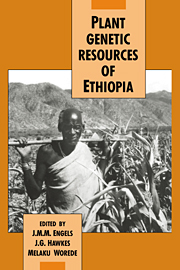Book contents
- Frontmatter
- Contents
- Contributors
- List of acronyms
- Preface
- Part I General introduction
- Part II The Ethiopian centre of diversity
- 2 The Ethiopian gene centre and its genetic diversity
- 3 Crops with wild relatives found in Ethiopia
- 4 Diversity of the Ethiopian flora
- 5 Forest genetic resources of Ethiopia
- 6 Plants as a primary source of drugs in the traditional health practices of Ethiopia
- 7 Traditional aromatic and perfume plants in central Ethiopia (a botanical and ethno-historical survey)
- 8 Spice germplasm in Ethiopia
- 9 A diversity study in Ethiopian barley
- 10 Sorghum history in relation to Ethiopia
- 11 Prehistoric Ethiopia and India: contacts through sorghum and millet genetic resources
- 12 Konso agriculture and its plant genetic resources
- Part III Germplasm collection and conservation in Ethiopia
- Part IV Evaluation and utilization of Ethiopian genetic resources
- Index
2 - The Ethiopian gene centre and its genetic diversity
Published online by Cambridge University Press: 30 October 2009
- Frontmatter
- Contents
- Contributors
- List of acronyms
- Preface
- Part I General introduction
- Part II The Ethiopian centre of diversity
- 2 The Ethiopian gene centre and its genetic diversity
- 3 Crops with wild relatives found in Ethiopia
- 4 Diversity of the Ethiopian flora
- 5 Forest genetic resources of Ethiopia
- 6 Plants as a primary source of drugs in the traditional health practices of Ethiopia
- 7 Traditional aromatic and perfume plants in central Ethiopia (a botanical and ethno-historical survey)
- 8 Spice germplasm in Ethiopia
- 9 A diversity study in Ethiopian barley
- 10 Sorghum history in relation to Ethiopia
- 11 Prehistoric Ethiopia and India: contacts through sorghum and millet genetic resources
- 12 Konso agriculture and its plant genetic resources
- Part III Germplasm collection and conservation in Ethiopia
- Part IV Evaluation and utilization of Ethiopian genetic resources
- Index
Summary
Introduction
Based on the concept of gene centres, developed by N.I. Vavilov in the 1920s, Ethiopia represents one of the eight centres in the world where crop plant diversity is strikingly high and where some of the crops concerned became domesticated. The concepts of centres of origin and diversity have evolved considerably since Vavilov's days as shown for instance by Harlan (1975) and by Hawkes (1983). Nevertheless, some of the basic characteristics which apply to the majority of the world's gene centres generally hold also for Ethiopia though varying from one crop to another. The highly dissected highland of Ethiopia includes natural barriers formed by mountains (up to approximately 5000 m above sea level) or ravines (sometimes more than 1300 m deep) where crop plants would have evolved in isolation under primitive agricultural conditions. To this must be added the ancient and very diverse cultural history of its people, thus providing many thousands of years of artificial selection within the landrace populations since the early days of agriculture. However, several crops which possess an extremely high diversity in Ethiopia do not follow all the basic principles required for a centre of origin in a given crop. In the case of barley, for instance, no wild relatives are known within the country nor is there any archaeological evidence to indicate early cultivation or domestication.
- Type
- Chapter
- Information
- Plant Genetic Resources of Ethiopia , pp. 23 - 41Publisher: Cambridge University PressPrint publication year: 1991
- 21
- Cited by



